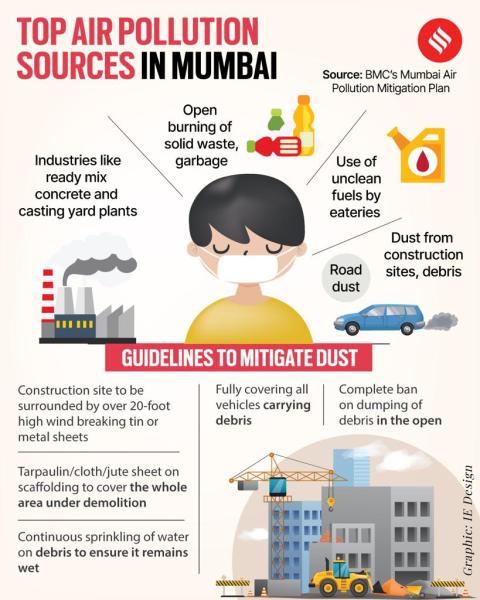Site after construction site, BMC’s rulebook gets a burial in the dust
The Indian Express visited construction sites in several neighbourhoods that have registered high AQI this past week.
 With mega infrastructure projects like the Mumbai Coastal Road Project, Mumbai Trans Harbour Link Road (MTHL) and Mumbai Metro being taken up by several government agencies, major portions of the city have been dug up, leading to suspension of particulate matter that linger in the air. (Express photo by Amit Chakravarty)
With mega infrastructure projects like the Mumbai Coastal Road Project, Mumbai Trans Harbour Link Road (MTHL) and Mumbai Metro being taken up by several government agencies, major portions of the city have been dug up, leading to suspension of particulate matter that linger in the air. (Express photo by Amit Chakravarty) When it released the Mumbai Air Pollution Mitigation Plan (MAPMP) in March this year, the BMC laid down a set of very specific guidelines: from setting up a 20-foot-high barrier around the construction site to using tarpaulin on scaffoldings to prevent dust or debris from rising up in the air to regular sprinkling of water to keep the dust down.
However, a visit by The Indian Express to key construction sites being managed by both the civic body and private parties shows that the BMC’s rulebook is, well, gathering dust.
Seven months into the guidelines, no action has been taken against anyone for violation. A new provision for penalising violators is in the making, officials said, and will be implemented over the next one week. But no one’s waiting.
The Indian Express visited construction sites in several neighbourhoods that have registered high AQI this past week. Consider the following examples that illustrate the glaring gap between rules and implementation.
 Chronic obstructive pulmonary disease (COPD). (Credit: Amit Chakravarty)
Chronic obstructive pulmonary disease (COPD). (Credit: Amit Chakravarty)
Site 1: Bullet Train Station Project at Bandra Kurla Complex (BKC)
AQI: 229 (on October 14)
The site for this mega infrastructure project being undertaken in the city is a casting yard that was a vast land parcel spread across a few hundred metres. The number of cranes, JCBs and trucks present at the site indicate the volume of the ongoing civil work.
While barricades, in line with norms, were seen on one side of the site’s periphery, low barricades had been erected on the other side, which failed to prevent dust from mucking the air.
In response to queries by The Indian Express on violations of MAPMP guidelines at the site, an official from the National High Speed Rail Corporation Ltd (NHSRCL) said, “Due to a three-day exhibition at the adjacent MMRDA ground, traffic movement has been allowed through the construction site temporarily. This movement has resulted in dust dispersal at the site. We regularly follow measures to mitigate dust, such as sprinkling of water on the ground. Mist guns will soon be installed at the site.”
 Construction for the Bullet Train Station Project is ongoing at Bandra Kurla Complex (BKC). (Express photo by Amit Chakravarty)
Construction for the Bullet Train Station Project is ongoing at Bandra Kurla Complex (BKC). (Express photo by Amit Chakravarty)
Site 2: Construction of a new bridge on Eastern Express Highway in Ghatkopar
AQI: 212 (on October 18 at Chembur)
A bridge was demolished at this spot recently by the civic authorities to make way for a new one. Seen sitting on top of the debris were two JCBs. As they drilled the accumulated stones at the spot into chips, the entire traffic junction got engulfed in a thin layer of dust.
Violation of multiple MAPMP guidelines were observed at the site, which comprises regular metal barricades and a thin green cloth in the name of following SOPs. Missing were the 20-foot metal sheets and sprinkling of the site with water.
 Guidelines to mitigate dust
Guidelines to mitigate dust
While contractors at the site refused to comment, a civic official said, “This is a very tight spot. If we erect 20-foot sheets here, the JCBs and cranes will not be able to move. We remove the debris at night in covered trucks. Once all the debris is cleared, we will ensure that all the SOPs are in place before the construction of the new bridge starts.
 An old bridge has been demolished by the civic body to construct a new one on Eastern Express Highway in Ghatkopar. (Express photo by Amit Chakravarty)
An old bridge has been demolished by the civic body to construct a new one on Eastern Express Highway in Ghatkopar. (Express photo by Amit Chakravarty)
Site 3: Real estate project by a private developer in Worli
AQI: 199 (on October 16 and 18)
A building is being demolished at this site and excavation work on the foundation is on. Five JCBs are operational and the entire site is covered in a blanket of dust. Contrary to the MAPMP guidelines, water is not being sprinkled on the debris. Twenty-foot high barricades are present to guard the compound, but tarpaulin sheets are missing.
“All construction debris is dumped inside the compound and transported in trucks later,” said a worker at the spot.
Not a single worker was seen wearing protective gear, including a mask. “We understand that this (the pollution) is dangerous for us but we are used to it now,” the worker added.
 A real estate project has been undertaken by a leading private developer at Worli. (Express photo by Amit Chakravarty)
A real estate project has been undertaken by a leading private developer at Worli. (Express photo by Amit Chakravarty)
Site 4: Bridge construction by BMC at Mith Chowky in Malad
AQI: 232 (on October 18)
The civic authorities have erected a 5-foot-high metal barricade when rules mandate tin and metal sheets more than 20 feet in height around the periphery of the site. The site did not have any covering sheets.
When asked about this absence, an official at the site said: “Since we don’t carry out civil works during the monsoon season, the sheets and precautionary measures aren’t in place. Work is ongoing at a major traffic junction and adding more barricades will affect vehicular movement… there are traffic snarls here already.”
When asked about the construction dust and its impact on the environment, he declined to comment.
 A bridge is being constructed by the BMC at Mith Chowky in Malad. (Express photo by Amit Chakravarty)
A bridge is being constructed by the BMC at Mith Chowky in Malad. (Express photo by Amit Chakravarty)
Site 5: Repair works at Dr Peter Dias Road near Mehboob Studio in Bandra
AQI: 411 (on October 18 at Vile Parle)
A site visit revealed that three trenches had been dug up to carry out utility-based repair work by both the civic agency and private parties. Besides the trenches being surrounded by piles of uncovered debris, including gravel and soil, no water was sprinkled at the spot — a violation of MAPMP guidelines — forcing both passers-by and residents to breathe in clouds of dust.
Workers at the site said, “We face health issues because of the dust, but what choice do we have? We have been doing this work for the past 25 years. No one has instructed us to cover the debris or sprinkle water at the site. We have also not been provided with masks, something that has resulted in several health issues.”
 Repair works are on at Dr Peter Dias Road near Mehboob Studio in Bandra by the civic body and private agencies. (Express photo by Amit Chakravarty)
Repair works are on at Dr Peter Dias Road near Mehboob Studio in Bandra by the civic body and private agencies. (Express photo by Amit Chakravarty)
Site 6: Ready-mix concrete (RMC) plant in Mulund East
AQI: 219 (on October 13 and 19)
The MAPMP lists RMC plants as one of the major contributors to air pollution in the city. With the plant operating in the middle of a bustling residential cluster in Mulund’s Ghati Pada locality, residents say they are suffering on two fronts — air pollution and pulmonary issues.
Speaking to The Indian Express, Bharat Soni, a resident of the nearby Swapna Nagari complex and the secretary of the Hillside Residents’ Welfare Association, said, “The air quality here makes me feel like I live inside a factory.”
He added, “I have been living here since 1987. We could see greenery from our building then. Over the years, many establishments, including the RMC plant, came up in the area. How can an RMC plant be permitted to be built in the middle of a residential neighbourhood? Since the establishment of this plant, which supplies materials to an under-construction project nearby, we also have to put up with noise pollution all day — loud noises from the plant in the morning and the sound of heavy machinery at night.”
He claimed that pulmonary issues in the area were on the rise due to this plant. “The shops and vehicles inside the building are always covered in a film of dust. Though almost every resident here suffers from respiratory issues, we cannot afford to relocate elsewhere,” Soni said.
 An RMC plant has been operating in the middle of a bustling residential cluster at Mulund’s Ghati Pada locality. (Express photo by Deepak Joshi)
An RMC plant has been operating in the middle of a bustling residential cluster at Mulund’s Ghati Pada locality. (Express photo by Deepak Joshi)
Common culprits and revised guidelines
With mega infrastructure projects like the Mumbai Coastal Road Project, Mumbai Trans Harbour Link Road (MTHL) and Mumbai Metro being taken up by several government agencies, major portions of the city have been dug up, leading to suspension of particulate matter that linger in the air.
Among the reasons identified by the MAPMP that were adding to Mumbai rising AQI levels were road dust, open burning of garbage, usage of unclean fuel sources at hotels and bakeries, and pollutants emanating from crematoriums, industries (like RMC, casting and hot mix plants) and informal sectors (like pottery), among others.
To queries by The Indian Express on flouting of construction SOPs in several neighbourhoods across the city, civic officials said they were working on modifying the existing MAPMP to deal with these violations and the violators.
Minesh Pimpale, the Deputy Municipal Commissioner (Environment), said, “There are no legal provisions at present to penalise such violators. The new draft (being made by the BMC) will include a hefty fine for such violations.”
Sudhakar Shinde, Additional Municipal Commissioner, told The Indian Express, “Though a robust plan (the MAPMP) is already in place, we are drafting a much more holistic policy that we aim to release soon. We have sent teams to Delhi to study the mitigation measures adopted there. Since Mumbai’s air quality is also affected by industrial emissions and garbage burning in nearby districts, we are in touch with municipal agencies in those places.”
In its MAPMP, the civic body had said that guidelines would be distributed among architects and contractors, besides government agencies including Maharashtra Housing and Area Development (MHADA), MMRDA, Slum Rehabilitation Authority (SRA), Maharashtra State Road Development Corporation (MSRDC), Maharashtra Industrial Development Corporation (MIDC) and Public Works Department (PWD), among others.
Shinde added, “Many aspects have to be considered when it comes to Mumbai’s climate. For instance, we have just concluded a study on air flow patterns above the sea and are roping in stakeholders like MMRDA (Mumbai Metropolitan Region Development Authority that oversees infrastructure development in the city) and CREDAI (the apex organisation of over 11,000 real estate developers). We will share the common set of guidelines with them.”







